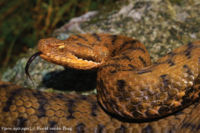| Viperinae | ||||||||||||||||
|---|---|---|---|---|---|---|---|---|---|---|---|---|---|---|---|---|

Asp viper,
Vipera aspis
|
||||||||||||||||
| Scientific classification | ||||||||||||||||
|
||||||||||||||||
|
Common names: pitless vipers, true vipers, Old World vipers.[2]
The Viperinae, or viperines, are a subfamily of
venomous
vipers found in
Europe,
Asia and
Africa. They are distinguished by their lack of the
heat-sensing pit organs that characterize their sister
group, the
Crotalinae. Currently, 12 genera and 66 species are
recognized.[3] Most are tropical and subtropical, although
one species, Vipera berus, even occurs within the Arctic
Circle.[2]
Contents |
Description
Members of this subfamily range in size from Bitis schneideri, that grows to a maximum of 28 cm, to Bitis gabonica that reaches a maximum length of over 2 m. Most species are terrestrial, but a few, such as Atheris, are completely arboreal.[2]
Although the heat-sensing pits that characterize the Crotalinae are clearly lacking in the viperines, a supernasal sac with sensory function has been described in a number of species. This sac is an invagination of the skin between the supranasal and nasal scales and is connected to the ophthalmic branch of the trigeminal nerve. The nerve endings here resemble those in the labial pits of boas. The supernasal sac is present in Daboia, Pseudocerastes and Causus, but is especially well developed in Bitis. Experiments have shown that strikes are not only guided by visual and chemical cues, but also by heat, with warmer targets being struck more frequently than colder ones.[2]
Geographic range
Europe, Asia and Africa.[1] However, they do not occur in Madagascar.[4]
Reproduction
Generally, members of this subfamily are viviparous (ovoviviparous), although a few, such as Pseudocerastes, lay eggs.[2]
Genera
| Genus[3] | Species | Subsp.* | Common name | Geographic range[1] |
|---|---|---|---|---|
| Adenorhinos | 1 | 0 | Uzungwe viper | Central Tanzania: Udzungwe and Ukinga Mountains. |
| Atheris | 8 | 1 | Bush vipers | Tropical subsaharan Africa, excluding southern Africa. |
| Bitis | 14 | 2 | Puff adders | Africa and the southern Arabian Peninsula. |
| Cerastes | 3 | 0 | Desert vipers | North Africa eastward through Arabia and Iran. |
| Daboia | 1 | 1 | Russell's viper | Pakistan, India, Sri Lanka, Bangladesh, Nepal, Myanmar, Thailand, Cambodia, China (Kwangsi and Kwantung), Taiwan and Indonesia (Endeh, Flores, east Java, Komodo, Lomblen Islands). |
| Echis | 8 | 6 | Saw-scaled vipers | India and Sri Lanka, parts of the Middle East and Africa north of the equator. |
| Eristicophis | 1 | 0 | McMahon's viper | The desert region of Balochistan near the Iran-Afghanistan-Pakistan border. |
| Macrovipera | 4 | 4 | Large Palearctic vipers | Semideserts and steppes of northern Africa, the Near and Middle East, and the Milos Archipelago in the Aegean Sea. |
| Montatheris | 1 | 0 | Montane viper | Kenya: moorlands of the Aberdare range and Mount Kenya above 3000 m. |
| Proatheris | 1 | 0 | Lowland viper | Floodplains from southern Tanzania (northern end of Lake Malawi) through Malawi to near Beira, central Mozambique. |
| Pseudocerastes | 1 | 2 | Horned vipers | From the Sinai of Egypt eastward to Pakistan. |
| ViperaT | 23 | 12 | Palearctic vipers | Great Britain and nearly all of continental Europe across the Arctic Circleand on some islands in the Mediterranean (Elba, Montecristo, Sicily) and Aegean Sea eastward across northen Asia to Sakhalin Island and North Korea. Also found in northern Africa in Morocco, Algeria and Tunisia. |
*) Not including the nominate subspecies (typical
form).
T)
Type genus.
Tribes
One tribe is currently recognized, Atherini, created by Broadley in 1996 to describe the genera Atheris, Adenorhinos, Montatheris and Proatheris. The type genus for this tribe is Atheris.[1]
Closely related groups
Until relatively recently, two other genera were also included in the Viperinae. However, they were eventually considered so distinctive within the Viperidae, that separate subfamilies were created for them:[1]
- Genus Azemiops - moved to subfamily Azemiopinae by Liem, Marx & Rabb (1971).
- Genus Causus - recognition of subfamily Causinae (Cope, 1860) was proposed by Groombridge (1987) and further supported by Cadle (1992).
Nevertheless, these groups, together with the genera currently recognized as belonging to the Viperinae, are still often referred to collectively as the true vipers.[2]
Cited references
- ^ a b c d e McDiarmid RW, Campbell JA, Touré T. 1999. Snake Species of the World: A Taxonomic and Geographic Reference, vol. 1. Herpetologists' League. 511 pp. ISBN 1-893777-00-6 (series). ISBN 1-893777-01-4 (volume).
- ^ a b c d e f Mallow D, Ludwig D, Nilson G. 2003. True Vipers: Natural History and Toxinology of Old World Vipers. Krieger Publishing Company, Malabar, Florida. 359 pp. ISBN 0-89464-877-2.
- ^ a b c Viperinae (TSN 563898). Integrated Taxonomic Information System. Accessed on 4 August 2006.
- ^ Stidworthy J. 1974. Snakes of the World. Grosset & Dunlap Inc. 160 pp. ISBN 0-448-11856-4.
Other references
- Breidenbach CH. 1990. Thermal cues influence strikes in pitless vipers. Journal of Herpetology 4:448-50.
- Broadley DG. 1996. A review of the tribe Atherini (Serpentes: Viperidae), with the descriptions of two new genera. African Journal of Herpetology 45(2):40-48.
- Lynn WG. 1931. The structure and function of the facial pit of the pit vipers. American Journal of Anatomy 49:97.